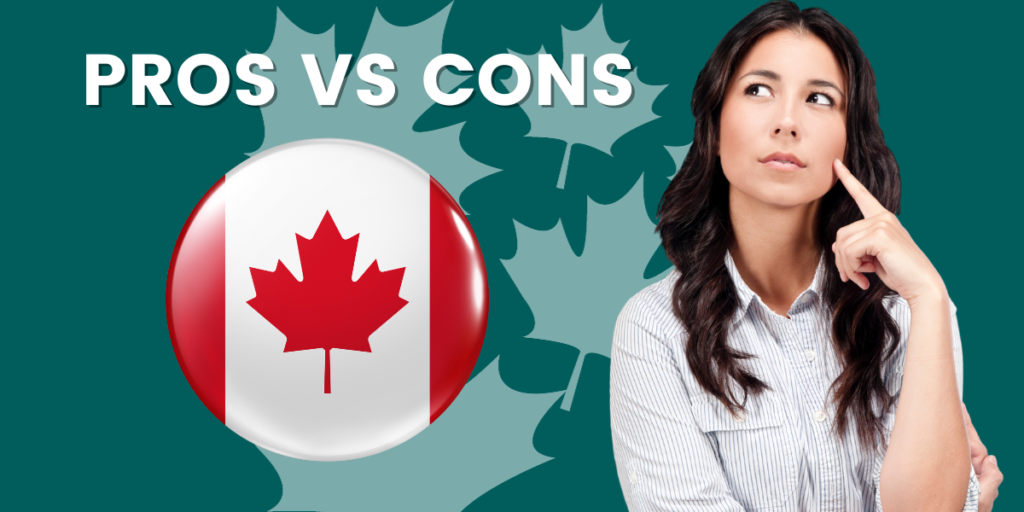Is Amazon FBA Canada Worth it in 2024? Our founder, Christina, shared the same concerns about Amazon Canada back in 2019 when she began selling exclusively on the Canadian marketplace. To her surprise, although a smaller market, Amazon Canada posed a great opportunity to grow her Amazon FBA business. If you want to establish a profitable Amazon FBA business, considering the Canadian marketplace is a viable option. But before you dive in, It’s crucial to consider some key factors before taking the plunge in the great white north.
In this article, we’ll delve into the unique factors that pertain to the Canadian Amazon marketplace in 2024. Let’s get started.
Table of Contents
- Is Amazon FBA Still Worth It In Canada in 2024?
- How Much Does the Average Amazon Seller Make in Canada?
- The Pros and Cons of Selling on the Canadian Amazon Marketplace
- Is the Canadian Amazon Marketplace Oversaturated?
- Is FBA Profitable for Amazon Sellers in Canada?
- What It Takes to Succeed on the Canadian Amazon Marketplace in 2024
- How to Register on Amazon.ca
- Be Mindful of Canadian Tax Regulations
- Take Stock of the Different Opportunities Amazon Offers
- How to Apply For Amazon Canada Brand Registry
- Conclusion
Is Amazon FBA Still Worth it in Canada in 2024?

As of 2024, the viability of Amazon FBA (Fulfillment by Amazon) in Canada largely depends on various factors, including your business strategy, product niche, and market dynamics. While the Canadian e-commerce landscape is continuously evolving, it still presents a promising opportunity for entrepreneurs seeking financial success. However, to determine whether Amazon FBA Canada is worth it, careful consideration of these factors is essential. Staying informed about market trends and adapting your approach accordingly can help ensure that Amazon FBA remains a worthwhile endeavour in the Canadian marketplace in 2024.
How Much Does the Average Amazon Seller Make in Canada?

The income of an average Amazon seller in Canada can vary widely, depending on factors such as product niche, business strategy, and market dynamics. Your success will depend on factors including organic ranking, pricing, conversion rates, PPC advertising(Pay-Per-Click), product category, and many other variables similar to any other Amazon marketplace. To estimate your potential Amazon Canada earnings, you can start by recording the price of a similar product, the number of customer reviews, the average review ratings, and the number of product variations available. Next, identify competitors with similar characteristics based on these four factors. Analyzing their sales performance will help you gauge where your earnings potential may fall within the Canadian market. Keep in mind that competitors with similar attributes may have varying revenue figures, so this exercise will provide you with a range of what your potential earnings might look like on the Canadian platform.
The Pros and Cons of Selling on the Canadian Amazon Marketplace

Just like any business model, running an Amazon FBA business in Canada comes with its set of advantages and disadvantages. Let’s explore a few of each that you should take into consideration
Pros of Selling on the Canadian Amazon Marketplace:
Access to a Growing Canadian Audience: The Canadian Amazon marketplace continues to expand, providing access to a steadily increasing customer base. This presents a fantastic opportunity for businesses looking to tap into this market without having to undertake expensive marketing campaigns.
Leveraging Amazon’s Reputation: Amazon has already earned the trust of millions of Canadian customers, who rely on the platform for their shopping needs. As an Amazon seller in Canada, you can leverage this trust to achieve high conversion rates.
Efficient Order Fulfillment: If you participate in the Amazon FBA program in Canada, your products will be shipped from Amazon’s fulfillment centres. This reduces the time and effort required for each order and maximizes your growth potential.
Offloading Operational Tasks: Running a successful e-commerce business involves various operational functions. When you’re part of the Amazon FBA program in Canada, many of these tasks, including warehousing, customer support, and payment processing, are managed on your behalf.
Cons of Selling on the Canadian Amazon Marketplace:
Fulfillment and Referral Fees: As an Amazon FBA seller in Canada, you’ll need to cover fulfillment and referral fees, which can impact your profit margins if you don’t have a solid understanding of unit economics.
Limited Customer Data: Similar to the international Amazon marketplace, the Canadian one allows you to sell products to customers but doesn’t permit you to collect their information for building your own audience. To cultivate a customer base, you’ll need to look beyond your Amazon FBA efforts.
Marketplace Competition: Competing products will be displayed alongside your listings, requiring you to compete for every sale.
Is the Canadian Amazon Marketplace Oversaturated?

The level of competition for Amazon sellers in Canada in 2024 is influenced by various factors, but it’s crucial to note that the Canadian market continues to grow. While more sellers are entering the marketplace, an increasing number of buyers are also joining the platform. Amazon Prime membership in Canada has been on the rise, with substantial revenue growth. This influx of buyers signifies opportunities for new sellers to establish and grow successful Amazon businesses in the Canadian market. Additionally, it’s essential to remember that over half of the sales on the Canadian Amazon marketplace are made by third-party sellers, indicating ongoing potential for growth.
Rather than being oversaturated, the Canadian Amazon marketplace can be viewed as a mature market with a healthy level of competition. This competition validates the legitimacy of the opportunity to build a genuine business and achieve financial freedom.
Is FBA Profitable for Amazon Sellers in Canada?
Profitability is at the core of any business venture, and Amazon FBA Canada is no exception. Let’s explore how fees, expenses, and market dynamics impact the profit margins of Amazon sellers in Canada. By understanding the financial aspects of FBA in the Canadian context, you can make informed decisions when embarking on your e-commerce journey in 2024.
- FBA Fees: One of the primary considerations for sellers is the FBA fees imposed by Amazon. These fees encompass storage, fulfillment, and referral fees, and will depend on the size and weight of your products. Sellers must meticulously calculate these fees to assess their impact on profit margins.
- Shipping Costs: The vast geography of Canada necessitates careful attention to various shipping costs. Sellers must factor in shipping expenses, as well as the shipping costs to deliver products to Canadian customers if choosing FBM. In some cases shipping by air may be a faster option for delivery to fulfilment centres but more costly.
- Import Duties and Taxes: If sellers are importing products into Canada, they should account for import duties and taxes. Being well-versed in these regulations can help optimize costs.
- Marketplace Competition: As in any e-commerce landscape, competition plays a significant role in profitability. Understanding the competitive dynamics within the Canadian marketplace is crucial for pricing and sales strategies.
- Conversion Rates: A key determinant of profit margins is the conversion rate – how many visitors to a product listing actually make a purchase. Conversion rate optimization can significantly impact a seller’s bottom line.
- Currency Exchange: For sellers operating internationally, fluctuations in currency exchange rates can have financial implications. Monitoring exchange rates is vital, as it can impact revenue and expenses.
By understanding the financial aspects of FBA in the Canadian context, sellers can navigate the e-commerce landscape with confidence and make informed decisions that align with their goals in 2024. Whether you’re a seasoned seller or just beginning your e-commerce journey, staying attuned to the financial intricacies of FBA in regardless the marketplace is key to thriving.
What It Takes to Succeed on the Canadian Amazon Marketplace in 2024

Despite the competition, achieving success on the Canadian Amazon marketplace is entirely feasible. To do so, you need to commit to the following five key principles, specifically tailored to the Canadian marketplace in 2024:
- Don’t Just Be an Amazon Seller – Be an E-commerce Business Owner: Shift your perspective from being merely an “Amazon seller” to being an e-commerce business owner or a brand builder who happens to sell on the Canadian Amazon marketplace. This mindset will guide you to address specific customer needs with your products, setting the stage for building a thriving online business.
- Understand the Canadian Market’s Financial Dynamics: Familiarize yourself with the unique financial aspects of selling on the Canadian Amazon marketplace. A mature market with growing competition requires a thorough grasp of unit economics, Canadian-specific Amazon fees, shipping costs, and other financial factors to ensure profitability.
- Make Adequate Investments: In 2024, launching a private label brand on any Amazon marketplace may demand more substantial financial investments than in the past. Tools designed specifically for the Canadian market can help you identify product opportunities and validate demand. To increase your chances of success, consider a well-planned starting budget.
- Set Your Products Apart in the Canadian Marketplace: Given that competitors are listed alongside your products on the Canadian Amazon marketplace, you must identify ways to differentiate your offerings. Creating unique selling points and distinguishing your products from the competition is crucial to securing sales and thriving as a seller.
- Embrace a Long-Term Vision: In 2024, achieving quick profits on the Canadian Amazon marketplace may not be the norm. Instead, focus on your long-term goals. Building a prosperous Amazon business in Canada will likely require patience and persistence. Avoid the temptation to withdraw profits too early, as it can hinder the growth of your e-commerce brand.
How to Register on Amazon.ca
Before embarking on your Amazon.ca seller journey, it’s crucial to choose the most appropriate selling plan for your needs. Amazon.ca offers two primary plans for sellers: the Individual plan and the Professional plan.
Individual Plan: Under this plan, sellers are charged a nominal fee of CDN $1.49 for each item sold. If you anticipate selling fewer than 30 items per month, the Individual plan might be the most cost-effective choice for you.
Professional Plan: For sellers who foresee selling more than 30 items per month, the Professional plan is a solid option. It involves a fixed monthly fee of CDN $29.99, regardless of the number of items sold. This plan provides a cost-efficient solution for higher sales volumes.
You’ll have the flexibility to switch between these plans at your convenience, making it easy to adapt to changing business needs as you grow your presence on Amazon.ca. In our experience, sellers tend to gravitate towards the Professional selling plan to unlock the array of advanced selling tools provided by Amazon.
When selecting your preferred plan, it’s essential to prepare the following information to facilitate a seamless registration process:
- Bank account details, including your bank routing number
- Credit card information
- Government-issued national identification & a valid phone number
- Tax-related info
Having these details readily available ensures a smooth and efficient registration process, allowing you to get started with your Amazon selling journey without unnecessary delays.
Be Mindful of Canadian Tax Regulations
For international Amazon sellers looking to navigate the complexities of sales tax in Canada, there are crucial considerations. If you are not required or prefer not to register for the GST/HST (Goods and Services Tax/Harmonized Sales Tax), Amazon can manage the calculation, collection, and remittance of sales tax on your behalf. While this may seem like a convenient option, it comes with limitations. Without a GST/HST number, your ability to scale your Amazon business is restricted due to a sales cap imposed on unregistered sellers. Furthermore, by not registering, you may miss out on potential tax advantages. Registering for GST/HST provides the opportunity to recover import duties and fees you’ve paid, allowing you to deduct these incurred expenses from your GST/HST amount. This, in turn, reduces your overall tax liability.
Non-resident sellers and resident sellers that exceed $30,000 in Canadian dollars over a 12-month period, may find themselves obligated to independently register for, collect, and remit sales taxes. Registering also enables the recovery of import duties and fees, allowing you to deduct these costs from your GST/HST amount. To successfully expand your Amazon business in Canada, GST/HST registration is a necessity, and obtaining a business number is the initial step in this process. You can initiate this process by accessing the RC1 form on the Government of Canada’s official website. Upon form submission, you can expect to receive your GST/HST number within one to two months.
To ensure accurate sales tax filings and full compliance with these tax obligations, it is highly advisable to seek professional guidance from tax experts. Do not consider this information as tax advice. Always speak to your account about tax obligations, regulations and requirements.
Take Stock of the Different Opportunities Amazon Offers
Navigating the fiercely competitive Amazon environment has become more demanding than ever, emphasizing the critical need for establishing a strong brand presence. Amazon consistently prioritizes brands and branded content, highlighting the significance of harnessing essential tools like Amazon Brand Registry, regardless of your chosen marketplace.
The gateway to unlocking the full potential of distinctive marketing and branding features frequently revolves around enrolling in the Brand Registry program. Enrolment grants access to supplementary content modules and aids in cementing your reputation as a trusted brand within the Canadian marketplace. It serves as a powerful differentiator, setting your brand apart from other Canadian sellers who have yet to embark on this registration journey.
How to Apply For Amazon Canada Brand Registry
Elevating your brand’s protection and reaping the benefits of Amazon Canada Brand Registry involves a series of well-defined steps. The foundation of this process hinges on having an active registered trademark or a pending trademark application for your brand. This trademark serves as the linchpin for your eligibility to participate in the Brand Registry program.
Sellers have the option to select a trademark from Canada, the USA, the UK, or other eligible countries. You can then utilize your chosen trademark to gain access to the program. Different countries feature varying processing times for trademarks, making it advantageous to opt for a quicker trademark registration route is timing is of necessity. However, it’s crucial to emphasize that securing a trademark in a different country than the marketplace where you conduct your sales won’t assist in combating Amazon listing hijackers.
Follow these precise steps:
- Access Your Amazon Seller Central Account: Initiate the process by logging into your Amazon Seller Central account. In case you don’t have an account, create one to begin your Brand Registry journey.
- Navigate to the Brand Registry Section: Proceed to http://brandregistry.amazon.com, where you’ll discover the option to enroll in Amazon Brand Registry.
- Furnish Brand Information: Provide comprehensive details about your brand, ensuring that they align precisely with the information on your registered trademark documentation. Accuracy and consistency with your trademark are paramount.
- List Your Products: Following the submission of brand information, you’ll need to list the products associated with your brand. This step establishes the connection between your brand and the products you offer.
- Submit Your Application: Carefully review the information you’ve provided and proceed to submit your application for Amazon’s meticulous review.
- Verification and Approval: Amazon’s dedicated team will meticulously review your application, verifying the accuracy of the information provided. If all requirements are met, your brand will earn approval for Amazon Brand Registry.
Once your brand secures approval, you can harness the program’s valuable benefits. Benefits include access to additional content sections like: Amazon A+ Content, the Amazon Brand Story, Product Videos, and an Amazon Storefront. You’ll also gain more control over your product listings, and counterfeiters. Prior to initiating the application process, ensure that you have the requisite trademark documentation and information readily available to expedite the procedure.
Marketplace Expansion Ss the Key to Your Success
The viability of selling on the Canadian Amazon marketplace in 2023 hinges on your approach and dedication. If you’re prepared to follow these tailored principles, work diligently, and maintain patience, the Canadian Amazon marketplace remains one of the most promising avenues to create a successful online business. Many first-time business owners have found success in the Canadian market, and you can too.
Questions about selling on Amazon Canada? Drop them below.

LIKE THIS ARTICLE?